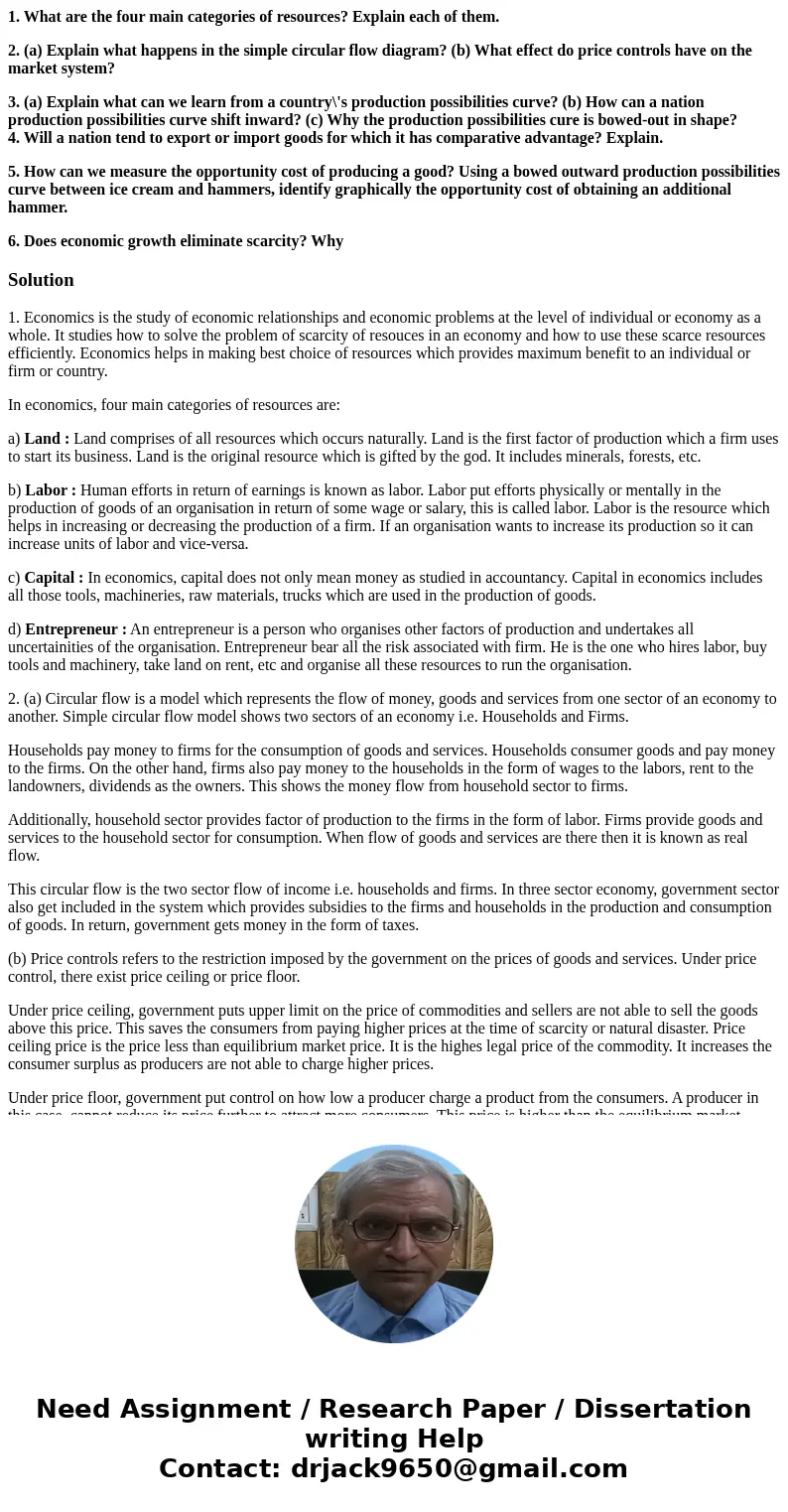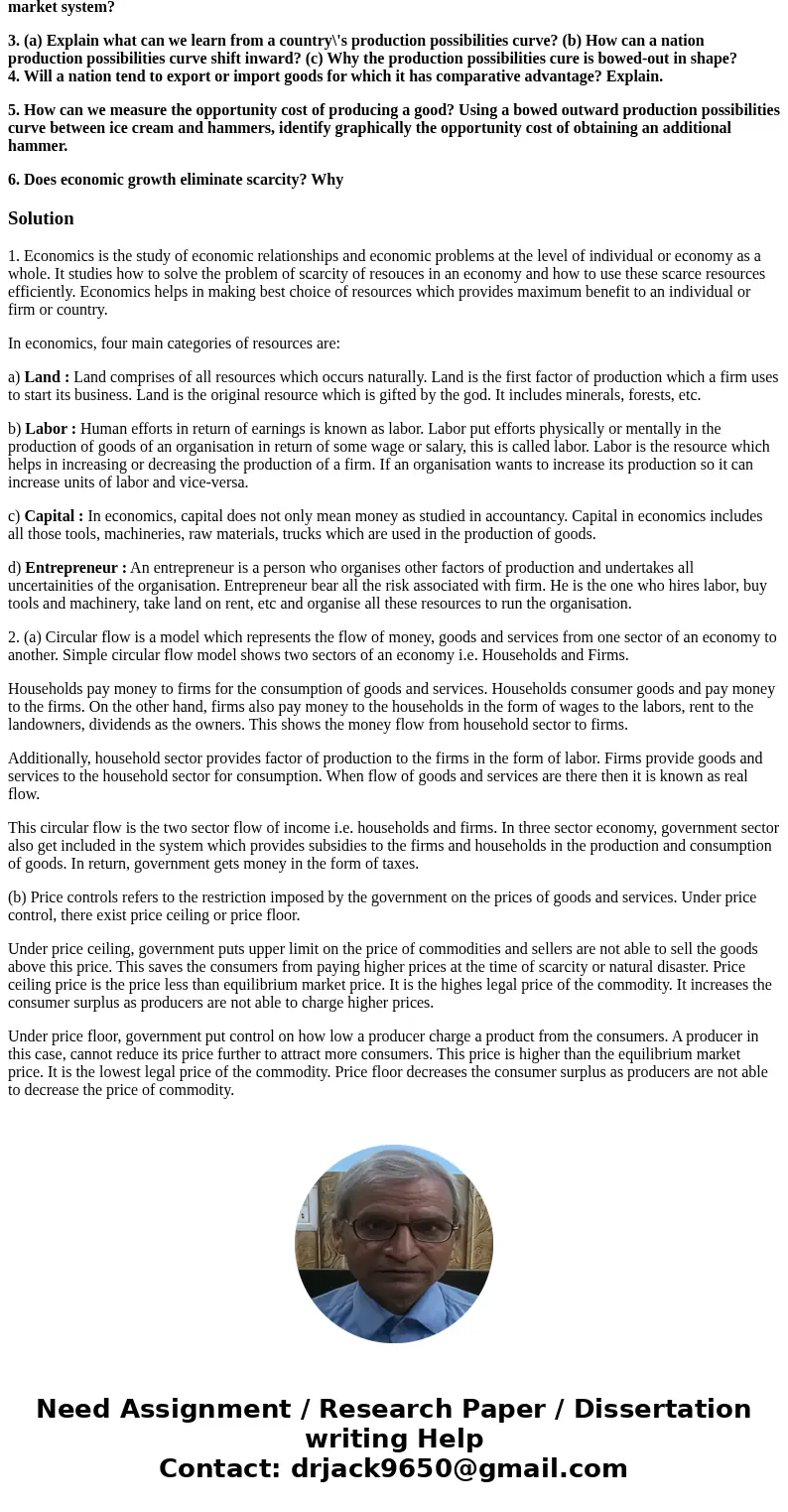1 What are the four main categories of resources Explain eac
1. What are the four main categories of resources? Explain each of them.
2. (a) Explain what happens in the simple circular flow diagram? (b) What effect do price controls have on the market system?
3. (a) Explain what can we learn from a country\'s production possibilities curve? (b) How can a nation production possibilities curve shift inward? (c) Why the production possibilities cure is bowed-out in shape?
4. Will a nation tend to export or import goods for which it has comparative advantage? Explain.
5. How can we measure the opportunity cost of producing a good? Using a bowed outward production possibilities curve between ice cream and hammers, identify graphically the opportunity cost of obtaining an additional hammer.
6. Does economic growth eliminate scarcity? Why
Solution
1. Economics is the study of economic relationships and economic problems at the level of individual or economy as a whole. It studies how to solve the problem of scarcity of resouces in an economy and how to use these scarce resources efficiently. Economics helps in making best choice of resources which provides maximum benefit to an individual or firm or country.
In economics, four main categories of resources are:
a) Land : Land comprises of all resources which occurs naturally. Land is the first factor of production which a firm uses to start its business. Land is the original resource which is gifted by the god. It includes minerals, forests, etc.
b) Labor : Human efforts in return of earnings is known as labor. Labor put efforts physically or mentally in the production of goods of an organisation in return of some wage or salary, this is called labor. Labor is the resource which helps in increasing or decreasing the production of a firm. If an organisation wants to increase its production so it can increase units of labor and vice-versa.
c) Capital : In economics, capital does not only mean money as studied in accountancy. Capital in economics includes all those tools, machineries, raw materials, trucks which are used in the production of goods.
d) Entrepreneur : An entrepreneur is a person who organises other factors of production and undertakes all uncertainities of the organisation. Entrepreneur bear all the risk associated with firm. He is the one who hires labor, buy tools and machinery, take land on rent, etc and organise all these resources to run the organisation.
2. (a) Circular flow is a model which represents the flow of money, goods and services from one sector of an economy to another. Simple circular flow model shows two sectors of an economy i.e. Households and Firms.
Households pay money to firms for the consumption of goods and services. Households consumer goods and pay money to the firms. On the other hand, firms also pay money to the households in the form of wages to the labors, rent to the landowners, dividends as the owners. This shows the money flow from household sector to firms.
Additionally, household sector provides factor of production to the firms in the form of labor. Firms provide goods and services to the household sector for consumption. When flow of goods and services are there then it is known as real flow.
This circular flow is the two sector flow of income i.e. households and firms. In three sector economy, government sector also get included in the system which provides subsidies to the firms and households in the production and consumption of goods. In return, government gets money in the form of taxes.
(b) Price controls refers to the restriction imposed by the government on the prices of goods and services. Under price control, there exist price ceiling or price floor.
Under price ceiling, government puts upper limit on the price of commodities and sellers are not able to sell the goods above this price. This saves the consumers from paying higher prices at the time of scarcity or natural disaster. Price ceiling price is the price less than equilibrium market price. It is the highes legal price of the commodity. It increases the consumer surplus as producers are not able to charge higher prices.
Under price floor, government put control on how low a producer charge a product from the consumers. A producer in this case, cannot reduce its price further to attract more consumers. This price is higher than the equilibrium market price. It is the lowest legal price of the commodity. Price floor decreases the consumer surplus as producers are not able to decrease the price of commodity.


 Homework Sourse
Homework Sourse